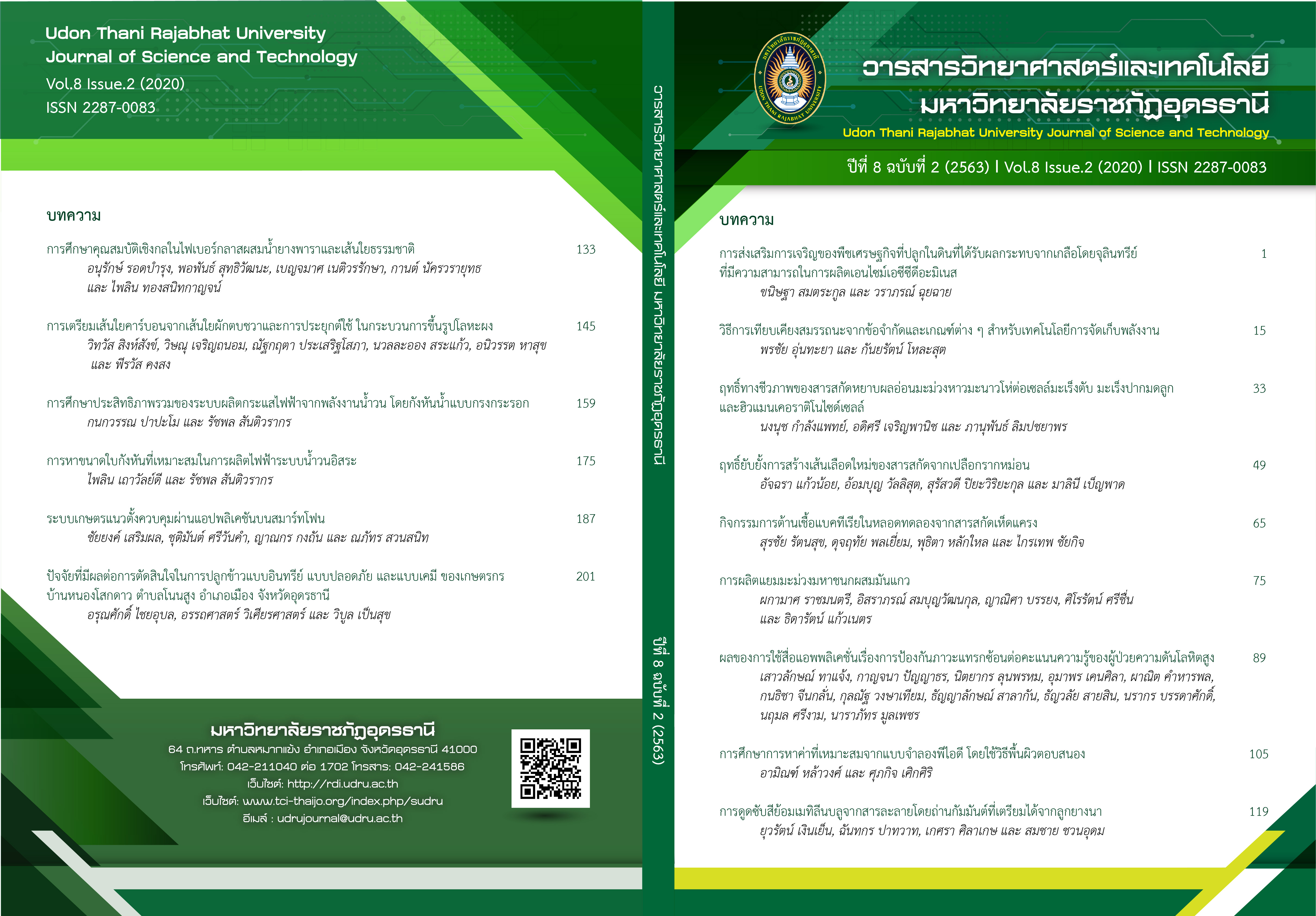ANTI-ANGIOGENESIS ACTIVITIES OF MULBERRY ROOT BARK EXTRACTS.
Main Article Content
Abstract
The aims of this study were to determine anti-angiogenesis activity of mulberry root bark extracts; hexane, dichloromethane and methanol. Betulinic acid and β-sitosterol were isolated from the hexane extract. All extracts and fractions obtained from column chromatography were tested for cytotoxicity against HUVECs cell. The concentrations which did not show any toxicity were in the range of 0.1-1.0 µg/ml, therefore these concentrations were used for determination of anti-angiogenesis activity. The sub-fractions of hexane extract gave better activity than the isolated pure compounds. The percentage of inhibition were 77.8-93.3% while betulinic acid and β-sitosterol gave only 73-85.8%. The dichloromethane extract without hexane solubles gave 69.4-86.7 percentage of inhibition. The dichloromethane solubles from methanolic extract (MeOH/CH2Cl2) gave the best antiangiogenesis activity, 95.4 %. Therefore, the antiangiogenesis activity of mulberry root bark extracts were due to betulinic acid and β-sitosterol in combination with other substances. The best activity was found with (MeOH/CH2Cl2) extract at 0.1 µg/ml in which betulinic acid and β-sitosterol were absent.
Article Details
References
อ้อมบุญ ล้วนรัตน์. (2552). การพัฒนาสารสกัดหม่อนที่มีฤทธิ์ยับยั้งเซลล์มะเร็ง รายงานวิจัยฉบับสมบูรณ์ สำนักงานคณะกรรมการวิจัยแห่งชาติ.
Arnaoutova, I., George, J., Kleinman, H. K., & Benton, G. (2009). The endothelial cell tube formation assay on basement membrane turns 20: state of the science and the art. Angiogenesis 12, 267–274.
Chuakul, W., Saralamp, P., Paonil, W., Temsiririrkkul, P., & Clayton, T. (1997). Medicinal plants in Thailand Vol. II. Siambooks and Publications Co. Ltd, p 103.
Gad, H.A., Ayoub, I.M., & Wink, M. (2019). Phytochemical profiling and seasonal variation of essential oils of three Callistemon species cultivated in Egypt. PLoS ONE, 14(7), e0219571. doi.org/10.1371/journal.pone.0219571
Gheorgheosu, D., Duicu, O., Dehelean, C., Soica, C., & Muntean, D. (2014). Betulinic Acid as a Potent and Complex Antitumor Phytochemical: A Minireview. Anticancer Agents Med. Chem., 14(7), 936-945.
Hurlbert, M. (2019) Retrieved July 28, 2019 from /https://www.curemelanoma. org/blog/article/cancer-facts-and-figures-new-2019-numbers-released-by-american-cancer-society
Keshet, E., & Ben-Sasson, S. A. (1999). Anticancer drug targets: approaching angiogenesis. J. Clin. Invest, 11, 1497-1501.
Kim H. M., Han S. B., Lee C. W., Kim C. Y., Lee E. J., & Huh, H. (2000). Immunomodulating activity of polysaccharide isolated from Mori Cortex Radicis. Arch Pharm Res, 23(3), 181-5.
Lee S. J., Chashi. Y., Sakurai, H., & Saiki, I. (2003). TAC-101 inhibits intrahepatic metastasis of orthotopically implanted murine hepatocellular carcinoma. Cancer Lett, 198, 169-177.
Liby, K. T., Yore, M. M., & Sporn, M. B. (2007). Triterpenoids and resinoids as multifunctional agents for the prevention and treatment of cancer. Nat. Rev. Cancer, 7, 357-369.
Nakamura, E. S, Koizumi, K., Yamaura, T., & Saiki, I. (2003). Antitumor angiogenic effect of a matrix metallo-proteinase inhibitors MM 1270. AnticancerRes, 23, 411-418.
Matthews, N. H., Li, W. Q., Qureshi, A. A., Weinstock, M. A., & Cho, E. (2019). Chapter 1 Epidemiology of Melanoma in Cutaneous Melanoma: Etiology and Therapy [Internet] NCBI Bookshelf. Retrieved 23 June, 2019 from https://www.ncbi.nlm.nih.gov/books/NBK481862/.
Ogasawa, M., Matsubura, T., & Suzuki, H. (2001). Inhibitory effects of evodiamine on invitro invasionand experimental lung metatstasis of murine colon cancer cells. Biol. Pharm. Bull, 20(8), 917-920.
Piyaviriyakul, S., Shimizu, K., Asakawa, T., Kan, T., Siripong, P., & Oku, N. (2011). Anti-angiogenic Activity and Intracellular Distribution of Epigallocatechin-3-gallate Analogs. Biol. Pharm. Bull., 34(3), 396-400.
Sato, H., Takino, T., Okada, Y., Cao, J., Shinagawa, A., Yamamoto, E., & Seiki, M. (1994). A matrix metalloproteinase expressed on the surface of invasive tumor cells. Nature, 370, 61-65.
Smitinand, T. (2014). Thai Plant Names, BKF Forest Herbarium, Department of National Parks, Wildlife and Plant Conservation, Revised Edition p.388
Snitmajaro, N. & Luanratana, O. (2008). A new source of whitening agent from a Thai Mulberry plant and its betulinic acid quantitation. Nat. Prod. Res., 22(9), 727-734.
WHO. (2019). How common is skin cancer? in Skin cancers. Retrieved 23 June, 2019 from https://www.who.int/uv/faq/skincancer/en/index1.html
Wagner, H., & Bladt, S. (1996). Plant Drug Analysis. (2nded.) Berlin:Springer-Verlag
Woodhouse, E. C., Chuaqui, R. F., & Liotta, L. A. (1997). General mechanism of metastasis. Cancer Supplement, 80(8), 1529-1537.


